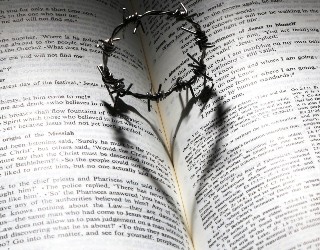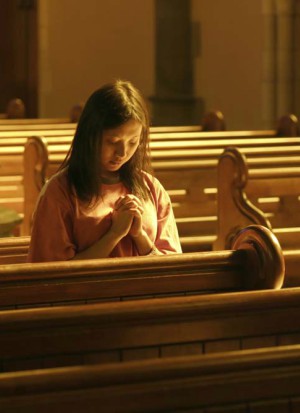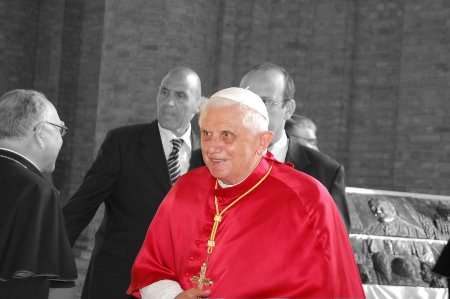We ask you, humbly: don't scroll away.
Hi readers, it seems you use Catholic Online a lot; that's great! It's a little awkward to ask, but we need your help. If you have already donated, we sincerely thank you. We're not salespeople, but we depend on donations averaging $14.76 and fewer than 1% of readers give. If you donate just $5.00, the price of your coffee, Catholic Online School could keep thriving. Thank you.Help Now >
Apostle John, the Seer of Patmos by Pope Benedict
FREE Catholic Classes
"The Wounded and Dead Lamb Conquers!"
CASTEL GANDOLFO, Italy, AUG. 24, 2006 (Zenit) - Here is a translation of Benedict XVI's address at Wednesday's general audience, dedicated to the Apostle John, whom he presented on this occasion as "the seer of Patmos."
The meditation is part of the series of reflections he is offering on the Church and the apostles.
* * *
Dear Brothers and Sisters,
In the last catechesis we meditated on the figure of the Apostle John. At first we tried to see how much can be known of his life. Then, in a second catechesis, we meditated on the central content of his Gospel, of his Letters: charity, love. And today we are again concerned with the figure of John, this time to consider the seer of Revelation.
We must immediately make an observation: Whereas his name never appears in the Fourth Gospel or the letters attributed to the apostle, [the Book of] Revelation makes reference to John's name four times (cf. 1:1,4,9; 22:8). On one hand, it is evident that the author had no reason to silence his name and, on the other, he knew that his first readers could identify him with precision. We know moreover that, already in the third century, the scholars argued over the true identity of the John of Revelation.
For this reason we can also call him "the seer of Patmos," because his figure is linked to the name of this island of the Aegean Sea, where, according to his own autobiographical testimony, he found himself deported "because of the word of God and the testimony of Jesus" (Revelation 1:19). Precisely on Patmos, "in the Spirit on the Lord's day," John had grandiose visions and heard extraordinary messages, which would have no little influence on the history of the Church and on the whole of Christian culture.
For example, from the title of his book, "Apocalypse" [Revelation], were introduced in our language the words "apocalypse, apocalyptic," which evoke, though inappropriately, the idea of an impending catastrophe.
The book must be understood in the context of the dramatic experience of the seven Churches of Asia (Ephesus, Smyrna, Pergamum, Tiatira, Sardi, Philadelphia and Laodicea), which toward the end of the first century had to face great difficulties -- persecutions and even internal difficulties -- in their witnessing of Christ. John addresses them, showing profound pastoral sensitivity for persecuted Christians, whom he exhorts to remain steadfast in the faith and not identify with the very strong pagan world.
His objective, in short, is to unveil, from the death and resurrection of Christ, the meaning of human history. The first and essential vision of John, in fact, concerns the figure of the Lamb, which, despite being slain, is standing (cf. Revelation 5:6), placed before the throne where God himself is seated. With this, John wants to tell us two things above all: The first is that Jesus, though he was killed with an act of violence, instead of lying fallen on the ground remains paradoxically standing firmly on his feet, because with the resurrection he has vanquished death definitively.
The second is that Jesus himself, precisely because he died and resurrected, now participates fully in the royal and salvific power of the Father. This is the fundamental vision. Jesus, the Son of God, is, on this earth, a defenseless, wounded and dead Lamb. And yet, he is standing, firm, before the throne of God and participates in the divine power. He has in his hands the history of the world. In this way, the visionary wishes to tell us: Have confidence in Jesus, do not be afraid of opposing powers, of persecution! The wounded and dead Lamb conquers! Follow Jesus, the Lamb, trust Jesus, follow his way! Even if in this world he seems to be the weak Lamb, he is the victor!
We ask you, humbly: don't scroll away.
Hi readers, it seems you use Catholic Online a lot; that's great! It's a little awkward to ask, but we need your help. If you have already donated, we sincerely thank you. We're not salespeople, but we depend on donations averaging $14.76 and fewer than 1% of readers give. If you donate just $5.00, the price of your coffee, Catholic Online School could keep thriving. Thank you.Help Now >
The object of one of the principal visions of Revelation is this Lamb at the moment he opens a book, which before was sealed with seven seals, which no one was able to open. John is even presented weeping, as no one could be found able to open the book and read it (cf. Revelation 5:4). History appears as undecipherable, incomprehensible. No one can read it.
Perhaps this weeping of John before the very dark mystery of history expresses the disconcertment of the Asian Churches because of God's silence in the face of the persecutions to which they were exposed at that time. It is a disconcertment which might well reflect our surprise in the face of the grave difficulties, misunderstandings and hostilities that the Church also suffers today in several parts of the world.
They are sufferings which the Church certainly does not deserve, as Jesus did not deserve punishment either. However, they reveal both man's maliciousness, when he allows himself to be led by the snares of evil, as well as the higher governance of events by God. So, only the immolated Lamb is capable of opening the sealed book and of revealing its content, to give meaning to this history which, apparently, often seems so absurd.
He alone can draw pointers and teachings for the life of Christians, to whom his victory over death brings the announcement and guarantee of the victory that they also, without a doubt, will attain. All the language John uses, charged with strong images, tends to offer this consolation.
At the center of the vision that Revelation presents is the extremely significant image of the Woman, who gives birth to a male Child, and the complementary vision of the Dragon, which has fallen from the heavens, but is still very powerful. This Woman represents Mary, the Mother of the Redeemer, but she represents at the same time the whole Church, the People of God of all times, the Church that at all times, with great pain, again gives birth to Christ. And she is always threatened by the power of the Dragon. She seems defenseless, weak.
But, while she is threatened, pursued by the Dragon, she is also protected by God's consolation. And this Woman, at the end, is victorious. The Dragon does not conquer. This is the great prophecy of this book, which gives us confidence! The Woman who suffers in history, the Church which is persecuted, at the end is presented as the splendid Bride, image of the new Jerusalem, in which there is no more tears or weeping, image of the world transformed, of the new world whose light is God himself, whose lamp is the Lamb.
For this reason, John's Revelation, though full of constant references to sufferings, tribulations and weeping -- the dark face of history -- at the same time presents frequent songs of praise, which represent, so to speak, the luminous face of history.
For example, it speaks of an immense crowd that sings almost shouting: "Alleluia! The Lord has established his reign, (our) God, the almighty. Let us rejoice and be glad and give him glory. For the wedding day of the Lamb has come, his bride has made herself ready" (Revelation 19:6-7). We are before the typical Christian paradox, according to which, suffering is never perceived as the last word; rather it is seen as a passing moment to happiness and, what is more, the latter is already mysteriously permeated with the joy that springs from hope.
Therefore, John, the seer of Patmos, can end his book with a final aspiration, in which an ardent hope palpitates. He invokes the Lord's final coming: "Come, Lord Jesus!" (Revelation 22:20). It is one of the central prayers of nascent Christianity, translated also by St. Paul in Aramaic: "Marana tha." And this prayer, "Come, Lord Jesus!" (1 Corinthians 16:22) has several dimensions.
Above all it implies, of course, the awaiting of the Lord's definitive victory, of the new Jerusalem, of the Lord who comes and transforms the world. But, at the same time, it is also a Eucharistic prayer: "Come, Jesus, now!" And Jesus comes, he anticipates his definitive coming. In this way, with joy, let us say at the same time: "Come now and come definitively!" This prayer also has a third meaning: "You have already come, Lord! We are certain of your presence among us. For us it is a joyful experience. But, come definitively!" Thus, with St. Paul, with the seer of Patmos, with nascent Christianity, we also pray: "Come, Jesus! Come and transform the world! Come now, today, and may peace conquer!" Amen.
[At the end of the audience, the Pope greeted pilgrims in several languages. In English, he said:]
Dear Brothers and Sisters,
Continuing our reflections on the teaching of the Apostle John, we now consider the Book of Revelation. The seer of Patmos, identified with the apostle, is granted a series of visions meant to reassure the Christians of Asia amid the persecutions and trials of the end of the first century.
John's central vision is that of the Lamb once slain, who now stands victoriously before God's throne, sharing in the Father's kingship and power (5:6ff). He alone is able to open the mysterious book closed with seven seals and to reveal, in the light of his own triumph over persecution and death, the ultimate meaning of history in God's providential plan.
The certain unfolding of God's victory is seen in John's visions of the Woman who gives birth to a Son destined to rule the nations (12:1ff.), the final defeat of the Dragon, and the heavenly Jerusalem, prepared as a bride adorned for the wedding feast (21:2ff.). As his book draws to an end, John invites Christians of every time and place to trust in the victory of the Lamb and to hope for the coming of God's Kingdom: "Come, Lord Jesus!" (22:20).
I am happy to greet all the English-speaking visitors present at today's audience, including the pilgrims from Taiwan, Japan and the United States of America. May your visit to Rome renew your faith in the Church, the bride of Christ, and may the Lord's definitive victory over all evil fill you with hope and courage. I invoke upon you God's blessings of joy and peace.
English original © Copyright 2006 -- Libreria Editrice Vaticana [adapted]
Contact
The Vatican
https://www.catholic.org
, VA
Pope Benedict XVI - Bishop of Rome, 661 869-1000
info@yourcatholicvoice.org
Keywords
Apostle, John, Pope, Benedict, Bible
More Catholic PRWire
Showing 1 - 50 of 4,716
A Recession Antidote
Randy Hain
Monaco & The Vatican: Monaco's Grace Kelly Exhibit to Rome--A Review of Monegasque-Holy See Diplomatic History
Dna. Maria St. Catherine Sharpe, t.o.s.m., T.O.SS.T.
The Why of Jesus' Death: A Pauline Perspective
Jerom Paul
A Royal Betrayal: Catholic Monaco Liberalizes Abortion
Dna. Maria St.Catherine De Grace Sharpe, t.o.s.m., T.O.SS.T.
Embrace every moment as sacred time
Mary Regina Morrell
My Dad
JoMarie Grinkiewicz
Letting go is simple wisdom with divine potential
Mary Regina Morrell
Father Lombardi's Address on Catholic Media
Catholic Online
Pope's Words to Pontifical Latin American College
Catholic Online
Prelate: Genetics Needs a Conscience
Catholic Online
State Aid for Catholic Schools: Help or Hindrance?
Catholic Online
Scorsese Planning Movie on Japanese Martyrs
Catholic Online
2 Nuns Kidnapped in Kenya Set Free
Catholic Online
Holy See-Israel Negotiation Moves Forward
Catholic Online
Franchising to Evangelize
Catholic Online
Catholics Decry Anti-Christianity in Israel
Catholic Online
Pope and Gordon Brown Meet About Development Aid
Catholic Online
Pontiff Backs Latin America's Continental Mission
Catholic Online
Cardinal Warns Against Anti-Catholic Education
Catholic Online
Full Circle
Robert Gieb
 Hi readers, it seems you use Catholic Online a lot; that's great! It's a little awkward to ask, but we need your help. If you have already donated, we sincerely thank you. We're not salespeople, but we depend on donations averaging $14.76 and fewer than 1% of readers give. If you donate just $5.00, the price of your coffee, Catholic Online School could keep thriving. Thank you. Help Now >
Hi readers, it seems you use Catholic Online a lot; that's great! It's a little awkward to ask, but we need your help. If you have already donated, we sincerely thank you. We're not salespeople, but we depend on donations averaging $14.76 and fewer than 1% of readers give. If you donate just $5.00, the price of your coffee, Catholic Online School could keep thriving. Thank you. Help Now >
Three words to a deeper faith
Paul Sposite
Relections for Lent 2009
chris anthony
Wisdom lies beyond the surface of life
Mary Regina Morrell
World Food Program Director on Lent
Catholic Online
Moral Clarity
DAN SHEA
Pope's Lenten Message for 2009
Catholic Online
A Prayer for Monaco: Remembering the Faith Legacy of Prince Rainier III & Princess Grace and Contemplating the Moral Challenges of Prince Albert II
Dna. Maria St. Catherine Sharpe
Keeping a Lid on Permissiveness
Sally Connolly
Glimpse of Me
Sarah Reinhard
The 3 stages of life
Michele Szekely
Sex and the Married Woman
Cheryl Dickow
A Catholic Woman Returns to the Church
Cheryl Dickow
Modernity & Morality
Dan Shea
Just a Minute
Sarah Reinhard
Catholic identity ... triumphant reemergence!
Hugh McNichol
Edging God Out
Paul Sposite
Burying a St. Joseph Statue
Cheryl Dickow
George Bush Speaks on Papal Visit
Catholic Online
Sometimes moving forward means moving the canoe
Mary Regina Morrell
Action Changes Things: Teaching our Kids about Community Service
Lisa Hendey
Easter... A Way of Life
Paul Spoisite
Papal initiative...peace and harmony!
Hugh McNichol
Proclaim the mysteries of the Resurrection!
Hugh McNichol
Jerusalem Patriarch's Easter Message
Catholic Online
Good Friday Sermon of Father Cantalamessa
Catholic Online
Papal Address at the End of the Way of the Cross
Catholic Online
Cardinal Zen's Meditations for Via Crucis
Catholic Online
Interview With Vatican Aide on Jewish-Catholic Relations
Catholic Online
Pope Benedict XVI On the Easter Triduum
Catholic Online
Holy Saturday...anticipation!
Hugh McNichol
We ask you, humbly: don't scroll away.
Hi readers, it seems you use Catholic Online a lot; that's great! It's a little awkward to ask, but we need your help. If you have already donated, we sincerely thank you. We're not salespeople, but we depend on donations averaging $14.76 and fewer than 1% of readers give. If you donate just $5.00, the price of your coffee, Catholic Online School could keep thriving. Thank you.Help Now >











 Daily Readings for Thursday, April 18, 2024
Daily Readings for Thursday, April 18, 2024 St. Apollonius the Apologist: Saint of the Day for Thursday, April 18, 2024
St. Apollonius the Apologist: Saint of the Day for Thursday, April 18, 2024 Aspiration: Prayer of the Day for Thursday, April 18, 2024
Aspiration: Prayer of the Day for Thursday, April 18, 2024

